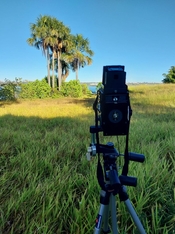Hello,
I've been experimenting with x-ray film (Fujifilm UM-MA) and have found an ISO/developer dilution that gives negatives of a good density and with a development time of around 10 minutes. Specifically, I'm exposing at ISO 16 and with a 1+4 dilution of D76H (non-hydroquinone type of D76 dev).
There are many situations where I would prefer to shoot at a higher ISO. If I decrease the developer dilution (eg. to 1+2 or even 1+1), raise the ISO (eg. to ISO 64) and adjust the development time accordingly to get an adequate density in the negative, what qualitative changes am I likely to see in the negative, ie. in terms of contrast and grain or other aspects?
Thanks,
I've been experimenting with x-ray film (Fujifilm UM-MA) and have found an ISO/developer dilution that gives negatives of a good density and with a development time of around 10 minutes. Specifically, I'm exposing at ISO 16 and with a 1+4 dilution of D76H (non-hydroquinone type of D76 dev).
There are many situations where I would prefer to shoot at a higher ISO. If I decrease the developer dilution (eg. to 1+2 or even 1+1), raise the ISO (eg. to ISO 64) and adjust the development time accordingly to get an adequate density in the negative, what qualitative changes am I likely to see in the negative, ie. in terms of contrast and grain or other aspects?
Thanks,












